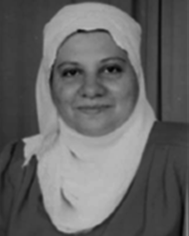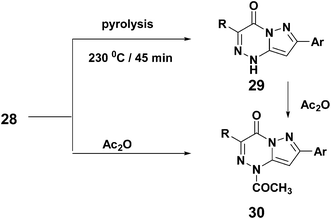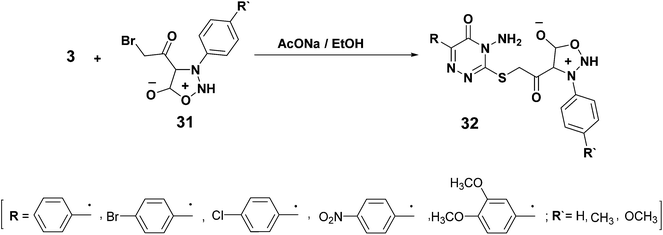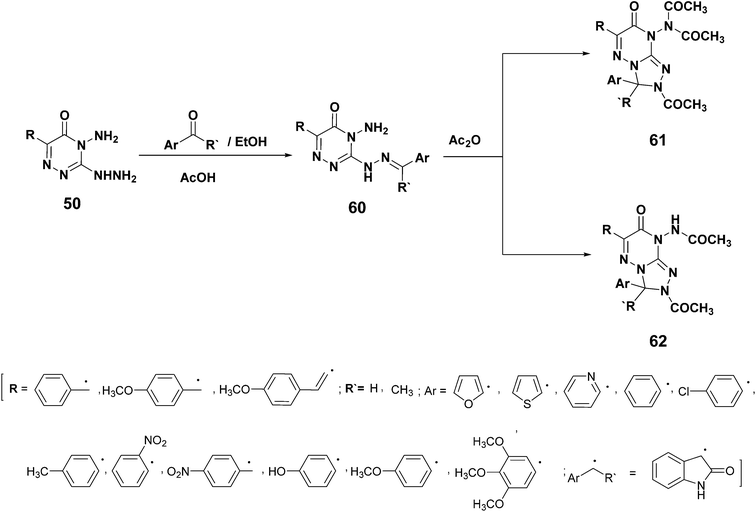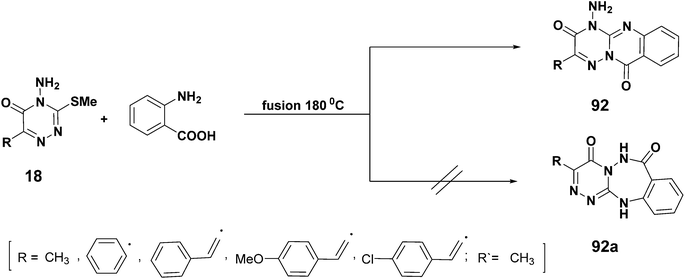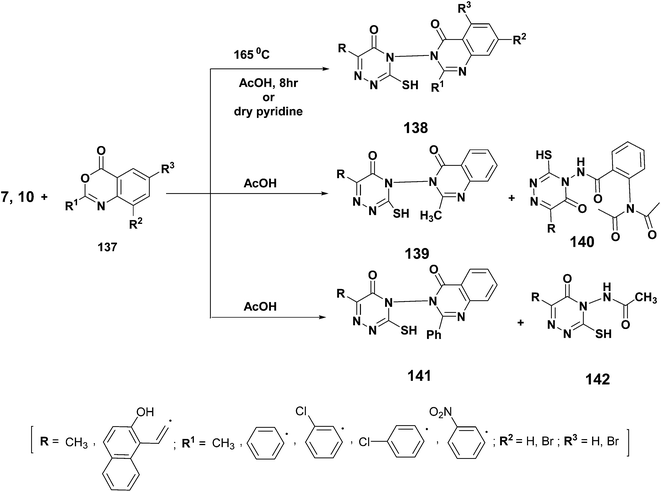Advances in the domain of 4-amino-3-mercapto-1,2,4-triazine-5-ones
Wafaa S. Hamama
*,
Ghada G. El-Bana
,
Saad Shaaban
,
O. M. O. Habib
and
Hanafi H. Zoorob
Department of Chemistry, Faculty of Science, Mansoura University, El-Gomhoria Street, Mansoura, ET-35516, Egypt. E-mail: wshamama53@gmail.com; wshamama@yahoo.com; Fax: +20 502246254; Tel: +20 502242388
First published on 22nd February 2016
Abstract
This review summarizes results from a literature survey concerning the synthesis and reactions of 4-amino-3-mercapto-1,2,4-triazine-5-ones reported by research groups from 1983 to mid. 2015.
O. M. O. Habib received his MSc and PhD from Faculty of Science, Cairo University in Chemistry at 1975 and 1978, respectively. He was prompted to Assistant Professor in 1982 then to Professor in 1990 until now. |
1. Introduction and scope
Triazines are an important class of nitrogen heterocycles that display diverse biological activities. They form an integral part of different therapeutically interesting compounds due to their similarity to the biologically active purine and pyrimidine scaffolds. The corresponding positions of nitrogen atoms to each other result in three isomeric triazines: 1,3,5-triazine, 1,2,3-triazine and 1,2,4-triazine (A–C).1 (Fig. 1).Triazines constitute classes of compounds interesting from the viewpoints of chemical reactivity and biological activity. 1,2,4-Triazine nucleus is a prominent structural core system present in numerous pharmacologically active compounds. 1,2,4-Triazines or its annulated compounds are important as the basic framework for a variety of chemotherapeutic agents. Azanucleosides (6-azacytosine and 6-azauracil), structurally based on the 1,2,4-triazine scaffold were proved to display anti tumor, antiviral, anti inflammatory, analgesic antihypertensive, cardiotonic, neuroleptic, antihistaminergic, tuber culostatic, anti protozoal, estrogen receptor modulators, antimalarial, cyclin-dependent kinase inhibitors, antiparasitic, antimicrobial and antifungal activities.2–8 In addition, some 1,2,4-triazin-6(1H)-ones were reported to display significant broad spectrum antitumor activity against lymphoblastic leukemia CEM, myeloid leukemia K562, and lung adenocarcinoma A549 cancer cell lines.9 While, some 1,2,4-triazin-5-one derivatives were found to show strong anti proliferative effect on human leukemia K-562 cell line.10 Moreover, particular interest has been focused on 6-azaisocytosine (3-amino-1,2,4-triazin-5(2H)-one), an isosteric isomer of 6-azacytosine and 6-azauracil as potential transcription inhibitor.11a 1,2,4-Triazines are versatile bioorthogonal reagents.11b
2. Synthesis of 6-(substituted)-4-amino-3-mercapto-1,2,4-triazin-5-ones
A variety of methods are available in the literature for the synthesis of 6-(substituted)-4-amino-3-mercapto-1,2,4-triazin-5(4H)-one via using various chemical building blocks according to the following reaction routes:2.1. Thiocarbohydrazide
The reaction of thiocarbohydrazide with different reagents was illustrated as depicted below:Also, reaction of thiocarbohydrazide 1 with alkali metal salts of 3,3-dimethyl-2-oxobutyric acid 8, (formed by treating of pinacolone with sulfur dichloride) followed by Me2NH and hydrolysis, gave 7 (Scheme 3).41
6-(Substituted)-4-amino-3-mercapto-1,2,4-triazin-5(4H)-ones 10 were obtained by condensing the appropriate arylidenepyruvic acids 9 with thiocarbohydrazide 1 (Scheme 4).2,19,33,42,43
3. Reactions
The latest literature survey of the reactions of 6-(substituted)-4-amino-3-mercapto-1,2,4-triazin-5-one 3 with different reagents can be classified according to the site of reagent attack and the relevant transformation of the formed substituent moieties as illustrated below:3.1. S-linked substituents and their annulated systems
Alkylation of compound 7 [R = methyl, t-butyl] with dimethyl sulfate in methanol afforded a mixture of N-methyl-1,2,4-triazin-5(4H)-one and S-methyl-1,2,4-triazin-5(4H)-one derivatives 17 and 18, respectively.49 While, alkylation of compounds 3 [R = benzyl, 4-chlorobenzyl, 4-methylbenzyl, 4-mthoxybenzyl, 3,4-dimethoxybenzyl], 5, 7, 10 and 11 with an alkyl halide in sodium methoxide afforded only S-alkylated products 18 (Scheme 8).14,24,25,29,30,35,37,42,44,50–53Alkylation of compounds 7 [R = methyl] and 10 [R = (2-thienyl)vinyl] with an alkyl halide in sodium ethoxide gave a mixture of the S-alkylated and the N-alkylated products 19 and 20, respectively. The composition of S- and N-alkylated products was affected by the reaction temperature. When the reaction had been formed under reflux, a higher ratio of S- vs. N-alkylated product was obtained. Therefore, the reaction was performed at room temperature to get the mixture product with a higher proportion of N-alkylated derivatives.53 In addition, the same reaction when carried either in (acetone/potassium hydroxide) or (ethanol/potassium hydroxide) yielded S-alkyl triazine derivatives 19 which have cytotoxic activity against different cancer cell lines.54,55 Alkylation of compound 7 and 10 with propargyl bromide in acetone/potassium carbonate afforded 4-amino-6-substituted-3-(prop-2-yn-1-ylthio)-1,2,4-triazin-5(4H)-ones 21.54,56 which cyclized to 1,3,4-thiadiazin-4-ones 22 in acetic acid (Scheme 9).56
When compound 10 [R = (2-thienyl)vinyl] was treated with alkylating agents as 4-bromobutyl acetate, 2-(bromomethoxy) ethyl acetate, 3-chloropropan-1-ol, 1,3-dichloropropan-2-ol or 2-(chloromethyl)oxirane in DMF and in the presence of K2CO3, acetyloxy-S-alkyl-1,2,4-triazinones 23, S-alkyl-1,2,4-triazinones 24 and 25 were obtained, respectively. Deacetylation of compound 22 in the presence of MeOH/TEA and a few drops of water yielded the deacetylated S-alkyl-1,2,4-triazineones 26 (Scheme 10).54
4-Amino-3-mercapto-1,2,4-triazin-5(4H)-one 3 [R = phenyl, benzyl, 4-chlorobenzyl, 4-methylbenzyl, 4-methylthiobenzyl] or 7 [R = hydrogen, 3-pentyl] were condensed with various substituted phenacyl bromides via two routes. In route a 3-arolylmethylsulfanyltriazines 27 were prepared through condensation of 3 or 7 with different phenacyl bromides in the presence of either EtOH/DMF/AcONa at room temperature or in refluxing EtOH/KOH. The triazinothiadiazinones derivatives 28 were constructed through refluxing of sulfanyltriazine 27 in (TsOH/EtOH), (pyridine/AcOH) or (EtOH/DMF/H2SO4) which showed antibacterial and antifungal activity against a variety of microorganisms.57–63 While, in route b compounds 28 could be formed directly by reacting 3 or 7 with the appropriate α-haloketones in ionic liquids (ethyl pyridinium tetrafluroroborate) (Scheme 11).63
Pyrolytic desulfurization ring contraction of 1,2,4-triazino[3,4-b]-1,3,4 thiadiazin-4-ones 28 [R = hydrogen, methyl, 4-cholrobenzyl, 4-methylbenzyl, phenyl] into their corresponding pyrazolo[5,1-c]-1,2,4-triazin-4-ones 29 (ref. 63) were implemented.63 Acetylation of 29 in acetic anhydride at refluxing temperature gave the corresponding 1-acetyl derivatives 30. In addition, compounds 29 were obtained by heating 28 in acetic anhydride (Scheme 12).63
The pyrolytic conversion of 28 to 29 was proposed to proceed as outlined in (Scheme 12). The 1,3-H shift and 1,5-H shift may be viewed as simple imine to enamine and vinylogous imine to enamine tautomerisms, respectively. This reaction resembles the Eschenmoser coupling reaction, which represents a versatile and efficient method to prepare vinylogous amides and urethanes by alkylating secondary and tertiary thioamides with an appropriate electrophilic component followed by elimination of sulfur (Fig. 2).
 | ||
| Fig. 2 Pyrolytic desulfurization ring contraction of 1,2,4-triazino-1,3,4-thiadiazinones 28 to pyrazolotriazinones 29. | ||
Reaction of 3-aryl-4-bromoacetylsynnones 31 with 6-(substituted)-4-amino-3-mercapto-1,2,4-triazin-5-one 3 in ethanol and sodium acetate gave S-substituted triazinone derivatives 32 which showed high antimicrobial and antifungal activities (Scheme 13).12
4-Amino-6-methyl-3-mercapto-1,2,4-triazin-5-one (7) when reacted with 33 in DMSO in the presence of triethylamine furnished 34, which was refluxed in NaOH, gave 1,2,4-triazino[3,4-b]-1,3,4-thiadizino[5,6-g]quinolone 35 which displayed antimicrobial and antifungal activities (Scheme 14).64
In addition, reaction of 7 on acrylonitrile through the mercapto group forming the cyanomethylthio-1,2,4-triazine derivatives 36 which condensed with 2,6-dichloro benzaldehyde in methanol and N,N-dimethylethylamine (DMEA) to afford the arylideneamino-1,2,4-triazine derivatives 37. Acid hydrolysis of 36 afforded the corresponding acid 37 while hydrolysis of compound 36 under the same condition, gave 4-amino-3-hydroxy-1,2,4-triazin-5-one as a hydrochloride salt 39 (Scheme 15).62
The reaction of compound 7 [R = methyl, phenyl] and 10 [R = (2-thienyl)vinyl] with malononitrile either in sodium ethoxide or pyridine provided the corresponding pyrazolo[5,1-c][1,2,4]triazine derivatives 40 as anticancer agents.65,66 Acid hydrolysis of 40 [R = phenyl] afforded the corresponding amide 41 (Scheme 16).65
Compound 10 [R = (2-hydroxynaphthyl)vinyl] with cyanamide in DMF afforded 1,2,4-triazolino[5,1-c]-1,2,4-triazin-4-one 42 (Scheme 17).4
Cyclocondensation of 1,2,4-triazin-5-ones 7 [R = methyl, t-butyl, phenyl] with phenyl isothiocyanate derivatives and/or N-methyl-3-oxo-3-aryl-propane thio-amide in pyridine at RT/or by refluxing afforded pyrazolo[5,1-c]-1,2,4-triazinones 43 and 44.4,67 Tricyclic ring system 45 could be formed by heating 7 [R = methyl, phenyl] with 3 [R = methyl, phenyl] in sodium methoxide solution (Scheme 18).65
Nucleophilic substitution of the methylthio group by carboxylic acid hydrazide moieties was carried out by the fusion of 4-amino-6-(tert-butyl)-3-methylthio-4,5-dihydro-1,2,4-triazin-5-one (7) with 2-(4-bromophenoxy)acetic acid hydrazide at 150–160 °C. It was found that the reaction is accompanied by rapid evolution of methanethiol and leads to formation of N1-[4-amino-6-(tert-butyl)-5-oxo-4,5-dihydro-1,2,4-triazin-3-yl]-N2-[2-(4-bromophenoxy)acetyl]hydrazine (46). On the other hand, a fusion of 7 [R = t-butyl] with hydrazides of p-chloro(bromo)benzoic acids, via nucleophilic substitution of the methylthio group by a hydrazide moiety is accompanied by a spontaneous cyclization to form bicyclic compounds 47 (Scheme 19).58
Boiling of compound 12 with CS2 in dil. ethanolic KOH yelided 1,3,4-thiadiazolo[2,3-c]-1,2,4-triazin-4-one 48 which reacted with chloroacetic acid to give the corresponding 2-substituted thioacetic acid 49 (Scheme 20).44,45
3.2. Exocyclic and endocyclic N-linked substituents and subsequent ring formation
Nucleophilic displacement reaction of compound 3, 10 and 18 with primary amino compounds and hydrazine derivatives yielded 3,4-diamino-1,2,4-triazin-5-ones 50.65,67 which exhibited antimicrobial activity against Aspergillus fumigatus, Penicillium italicum, Syncephalastrum racemosum, Candida albicans, Staphylococcus aureus, Pseudomonas aeruginosa, Bacillus subtilis, Escherichia coli (Scheme 21).68,69Condensation of 3-hydrazinyl-1,2,4-triazin-5(4H)-one 50 with isatin and/or isatoic anhydride in anhydrous boiling dioxane furnished the corresponding triazinoindol-2-one 51 and triazinoquinazoline-2,4-dione 52. Coupling compounds 51 and 52 with 2,3,4,6-tetra-O-acetyl-α-D-glucopuranosyl bromide in pyridine at room temperature gave the corresponding 2,3,4,6-tetra-O-acetyl-β-D-glucopyranosyl derivatives 53 and 54. Acetyl deblocking of 53 and 54 was achieved by their treatment with ammonia solution at room temperature to give the corresponding glucopyranosyl derivatives 55 and 56, (Scheme 22).69
When compound 50 was reacted with some aldoses namely, D-glucose, D-galactose, D-mannose, D-ribose, L-arabinose and/or D-xylose in anhydrous boiling dioxane yielded the corresponding sugar hydrazones of the hydrazinyl-1,2,4-triazin-5-ones 57a–f, respectively. Acetylation of the sugar hydrazones 57 with acetic anhydride in anhydrous pyridine at room temperature afforded the respective polyacetyl derivatives 58a–f (Scheme 23).69
Similarly, the hydrazide 50 when reacted with D-fructose under the same reaction conditions afforded the corresponding 2,3,4,5-tetrahydroxy-1-hydroxymethylpentylidene sugar 59 (Scheme 24).69
Furthermore, when compounds 50 [R = benzyl, 4-methoxybenzyl, 4-methoxystyryl; R1, R2 = hydrogen] were condensed with a variety of one carbon donors, such as aldehydes and ketones afforded the corresponding hydrazones 60 as promising anticancer drugs69,70 Treatment of compounds 60 [R = benzyl, 4-methoxy benzyl] with acetic anhydride to give either corresponding triacetylated heterobicyclic derivatives 1,2,4-triazolo[4,3-b]-1,2,4-triazine 61 or diacetylated derivatives 62 (Scheme 25).
The condensation reaction between 50 [R = benzyl, 4-methoxybenzyl] and triethyl orthoformate as the monocarbon donor in methanol and in the presence of catalytic amount of acetic acid furnished 1,2,4-triazolo[4,3-b]-1,2,4-triazin-7(8H)-ones 63 (Scheme 26).70
Cyclocondensation of 4-amino-3-hydrazinyl-6-benzyl (or substituted benzyl)-1,2,4-triazin-5(4H)-one 50 with carbon disulfide afforded 1,2,4-triazolo[4,3-b]-1,2,4-triazines 64 which then allowed to react with 2,3,4,6-tetra-O-acetyl-α-D-glucopuranosyl bromide in pyridine containing triethylamine to give the corresponding pyridinium salts 65. The free salt of 66 was achieved via treatment of compounds 65 with acetic acid (Scheme 27).2,69
Fusion of compound 66 with aromatic aldehydes at 150–160 °C gave the corresponding 8-arylideneamino derivatives 67.2 Oxidation of 66 with potassium permanganate at 25 °C furnished the corresponding triazolotriazine-3,7-diones 68. Acetyl deblocking of 66 was achieved by its treatment with ammonia solution at room temperature to afford the 2,3,4,6-tetrahydroxy-β-D-glucopyranosyl-1,2,4-triazinone derivatives 69 (Scheme 28).69
Deamination of compounds 66 were achieved by the action of nitrous acid gave the corresponding glucopyranosyltriazolotriazines 70. Thiation of compounds 70 with phosphorous pentasulphide gave the corresponding dithiones 71 while, using hydrogen peroxide in acetic acid gave the corresponding diones 72. Deacetylation of compounds 70 by treatment with methanolic ammonia afforded the corresponding free β-D-glucopyranosides 73 (Scheme 29).2
4-Amino-6-methyl-3-(substituted)-1,2,4-triazin-5(4H)-ones 50 are cyclized with formic acid to furnish 7-oxo-3,7-dihydro-triazolo[3,2-c]-1,2,4-triazines 74.65,71 The 1,2,4-triazolidino[5,1-c]-1,2,4-triazin-4,7-dione 75 was obtained via cyclization reaction of 4-[(4-amino-6-(2-(2-hydroxynaphthalen-1-yl)vinyl)-5-oxo-4,5-dihydro-1,2,4-triazine-3-yl)amino]benzene sulfonamide (50) with ethyl chloroformate in DMF.4 In addition, treating 50 [R = phenyl] with acetic anhydride afforded 7-oxo-2-methyl-6-phenyl-7H-l,3,4-oxadiazolo[2,3-c]-1,2,4-triazine (76) (Scheme 30).65
 | ||
| Scheme 30 Reaction of 1,2,4-triazines 50 with formic acid, ethyl chloroformate and with acetic anhydride. | ||
3.3. Heterocyclization of N-linked substituents
Heterocyclization reactions of compounds 50 on refluxing with mono chloroacetic acid and/or 1,1-diethoxy-2-bromoethane in basic medium (NaOH and/or NaOEt) furnished benzenesulfonamide derivatives 77 and 78, respectively (Scheme 31).4Aroylation of compounds 50 (R = (2-hydroxynaphthyl)vinyl) using furoyl chloride or 4-chlorobenzoyl chloride in DMF gave 1,2,4-triazino[3,4-c]-1,2,4,5-tetrazine-6-ones 79. In addition, acylation of compound 50 with ethyl chloroformate in DMF afforded the 1,2,4, triazino[4,3-e]-1,2,4,5-tetrazin-3,6-dione 80. While refluxing 50 with carbon disulfide in ethanolic potassium hydroxide yielded the isomeric thiones 81, respectively (Scheme 32).4
The Kabachnik–Fields reaction used 3,4-diamino-6-methyl-1,2,4-triazin-5(4H)-one (50), acetaldehyde and diethyl phosphite in THF in the presence of sodium hydride as a catalyst afford 1,2,4-triazino[4,3-b]-1,2,4,5-triaza phosphine derivative 83 through the non-isolable intermediate 82 which spontaneously cyclized with the elimination of an ethanol molecule (Scheme 33).68
One-pot, three components reaction of compound 4-amino-3-hydrazinyl-6-methyl-1,2,4-triazin-5(4H)-one (50) with acetaldehyde and phenylphosphonic dichloride in boiling THF containing a catalytic amount of triethylamine afforded 1,2,4,3-triazaphospholo[5,1-c]-1,2,4-triazinone derivative 84. While reaction of compound 50 with acetaldehyde and diethyl phosphite in THF in the presence of sodium hydride as a catalyst gave 1,2,4-triazino[3,2-c]-1,2,4,5-triazaphosphinine 85 via cyclization through N-2 of the triazine ring and not the exocyclic N-amino, with the elimination of one molecule of ethanol. Finally 1,2,4-triazino[4,3-e]-1,2,4,5,3-tetrazaphosphinin-8-one 86 and 1,2,4-triazino[4,3-e]-1,2,5,6,3-tetrazaphosphepin-7(1H)-one 87 were obtained by cyclocondensation of compound 50 with bis-(dimethylamino) methyl phosphonate in THF in the presence of few drops of hydrochloric acid and acetyl triphenylphosphonium chloride in DMF containing few drops of piperidine, respectively (Scheme 34).68
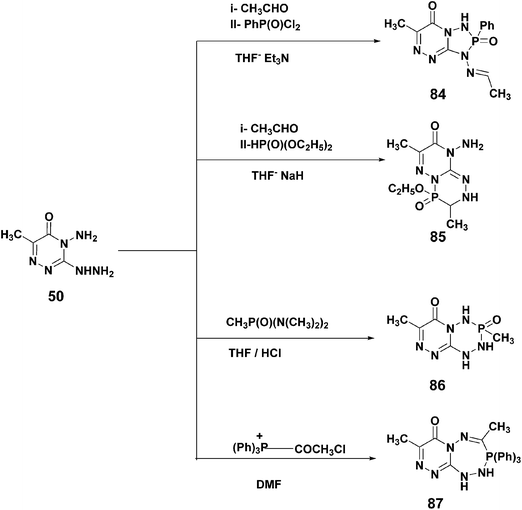 | ||
| Scheme 34 Synthesis of triazaphospholo 84, triazaphosphinine 85, tetrazaphosphinine 86 and tetrazaphosphepin 87-1,2,4-triazinone derivatives. | ||
4-Amino-3-hydrazinyl-6-methyl-1,2,4-triazine-5(4H)-one (50) was reacted with a wide variety of 1,2-bielectrophiles namely, 1,2,4-triazino[4,3-b]-1,2,4,5-tetrazepine derivatives 88–91, respectively (Scheme 35).72
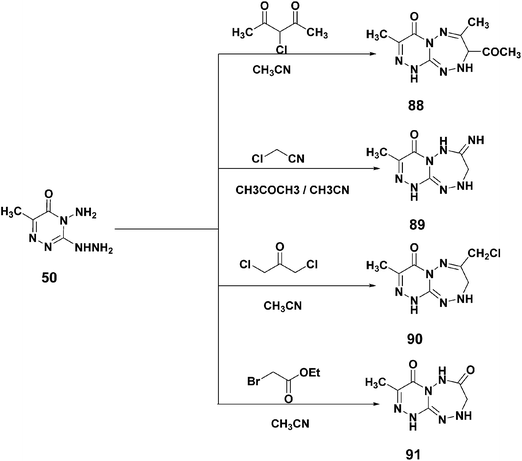 | ||
| Scheme 35 Reaction of 50 with different reagents to produce 1,2,4-triazino-1,2,4,5-tetrazepine derivatives 88–91. | ||
Reaction of compounds 18 with anthranilic acid gave a tricyclic system for which the 4-amino-2-substituted-3H-1,2,4-triazino[3,2-b]quinazoline-3,10(4H)-dione 92 were established rather than the expected condensed triazepines 92a (Scheme 36) (Fig. 3).42,73
 | ||
| Fig. 3 Plausible mechanism of formation 2-substituted-1,2,4-triazinoquinazolindiones 92 from 1,2,4-triazine 18. | ||
The amino group in compound 4-amino-2-methyl-3H-1,2,4-triazino[3,2-b]quinazolin-3,10(4H)-dione 92 was used for producing new heterocyclic derivatives. Thus, refluxing 92 with acetic anhydride in glacial acetic acid gave a mixture of the mono N-acetyl 93 and N,N-diacetyl 94 priducts. Similarly, the mono- and di-benzoyl products 95 and 96 were obtained when compound 92 was refluxed with benzoyl chloride in anhydrous pyridine. Refluxing 92 with phenyl isocyanate and/or phenyl isothiocyanate in DMF gave the corresponding triazino[3,2-b]quinazoline-3-phenylurea 97 (X = O) or 3-phenylthiourea 97 (X = S), respectively. On the other hand, thiation of compound 91 was carried out with phosphorus pentasulfide in anhydrous boiling dioxane to furnish 3-thioxo-1,2,4-triazino[3,2-b]quinazoline 98 as antimicrobial agents (Scheme 37).73
Condensation of compound 92 with different aldehydes afforded Schiff bases 1,2,4-triazino[3,2-b]quinazoline-3,10(4H)-dione 99.50 Deamination of compounds 92 via their treatment with nitrous acid afforded 100 (Scheme 38).42
Deamination of 18 into the target compound 101 was achieved in almost quantitative yields by the action of nitrous acid in acetic acid. Nucleophilic displacement reactions of compound 101 with aromatic amines afforded 1,2,4-triazine-5(4H)-one derivative 102 (Scheme 39).50
Whereas, 6-benzyl-4-methyl-3-(methylthio)-1,2,4-triazin-5(4H)-one (103) was prepared by reaction of methyl iodide in sodium methoxide with 6-(substituted)-3-(methylthio)-1,2,4-triazin-5(4H)-one (101) (R = benzyl) (Scheme 40).50
Once again, 6-benzyl-3-hydrazinyl-1,2,4-triazine-5(4H)-one (104) was prepared by reacting 18 and 103 with hydrazine. Condensation of equimolar quantities of 104 with aldehydes in acetic acid gave the corresponding N-[6-benzyl-5(4H)-1,2,4-triazinon-3-yl]hydrazones 105. The treatment of hydrazone derivatives 103 [Ar = phenyl, R1 = hydrogen] with FeCl3 in EtOH gave 6-benzyl-8-methyl-1,2,4-triazolo[4,3-b]-1,2,4-triazin-7(8H)-one (106) which also prepared via reaction of 6-benzyl-3-hydrazinyl-1,2,4-triazin-5(4H)-one (104) [R1 = H] with benzoyl chloride derivatives in pyridine (Scheme 41).50,74
3.4. N- and S-glycoside linked substituents and relevant skeletons
S-Glycoside acetylated pyranose 107 and S-riboside acetylated furanose 109 of 4-amino-3-mercapto-6-(2-(2-thienyl)vinyl)-1,2,4-triazin-5(4H)-one (10) have been synthesized via microwave irradiation (MWI, 2450 MHz, 800 W) and/or conventional methods with 2,3,4,6-tetra-O-acetyl-α-D-glucopuranosyl bromide and 2,3,5-tri-O-acetyl-β-D-ribofuranosyl bromide. Deacetylation of compounds 107 and 109 in the presence of MeOH/TEA afforded S-glucopyranose and S-ribofuranose-1,2,4-triazineones 108 and 110, respectively (Scheme 42).54Galactosidation of the 4-amino-6-substituted-3-thioxo-2,3-dihydro-1,2,4-triazin-5(4H)-ones (3, 7 and 10) with 2,3,4,6-tetra-O-acetyl-α-D-galactopyranosyl bromide in either N,N-dimethylformamide containing triethylamine or acetonitrile containing triethylamine afforded the corresponding 4-amino-2-(2,3,4,6-tetra-O-acetyl-β-D-galactopyranosyl)-6-substituted-3-thioxo-2,3-dihydro-1,2,4-triazine-5(4H)-ones 111 as anticancer agent.75,76 4-arylideneamino-2,3,4,6-tetra-acetyl galactopyranosyl-1,2,4-triazines 112 prepared by condensation reaction of 111 with aldehyde derivatives.76 Deamination of 111 into the target 2-β-D-galactosyl derivatives 113 was achieved in almost quantitative yields by the action of nitrous acid in acetic acid. Also, treatment of the appropriate acetyl derivatives 111 with methanolic ammonia led to the formation of the corresponding free L-arabinopyranosyl nucleosides 114 (Scheme 43).43,76
Benzoylation of N-2 glucosyl derivative 111 yielded the corresponding 4-(N-benzoylbenzamide) derivative 115. Acetylation of compound 111 with acetic anhydride in pyridine at r.t. afforded the corresponding mono-and diacetyl derivatives 116 and 117 (Scheme 43).76
Besides, methylation of compounds 113 with methyl iodide in DMF containing either sodium carbonate or triethylamine gave a mixture of the respective products 118 (O-methylation), 119 (N-methylation) and 120 (S-methylation) (Scheme 44).43
Thiation of compounds 113 with phosphorous pentasulfide in pyridine afforded the corresponding 3,5-dithiones 121. Glycosyl derivatives 122 was obtained by treatment of the appropriate acetyl derivatives 113 with methanolic ammonia as an active compounds against both MCF7 (breast) and SF-268(CNS) cell lines (Scheme 45).43,76
Heating of 2-β-D-galactosyl 113 was studied at different temperatures and the optimum conversion (100%) to the corresponding 3-β-anhydro-2-(3,4,6-tri-O-acetyl-β-D-talosyl)-3-mercapto-1,2,4-triazin-5(2H)-one 123 was achieved at 280 °C (87% yield) (Scheme 46).77
The proposed mechanism for conversation of the acetylated glycosyls 113 into their anhydrous derivatives 123 is illustrated in (Fig. 4). This involves the intra molecular SN2 (5-exo-tet) attack by the sulfur on C-2 of the glycosyl moiety followed by elimination of acetate (CH3COO−) and (H+), which ultimately produce acetic acid (Fig. 4).
 | ||
| Fig. 4 Pyrolysis of N-glycoside-1,2,4-triazinone 113 to form the corresponding anhydrous derivative 123. | ||
Furthermore, condensation of the 4-amino-1,2,4-triazin-5-ones 3, 7, 10, 18, 19 and 36 with aromatic aldehydes53,56,61,62,65,68,78–82 and ketones56,62 under different condition produced the hydrazones 124 that possess variable antibacterial activity against both Gram positive (B. subtilis, S. areas) and Gram negative (P. aeruginosa, E. coli) bacteria78 and antitumor activity against 2-cell lines MCF-7 (breast) and HEPG2 (liver).82 4-Arylideneamino-2,3-dihydro-3-thioxo-1,2-4-triazin-5(4H)-ones 124 reacted with bromo acetophenone derivatives or ethyl bromoacetate under different conditions and the best condition was achieved by stirring for 2 h in acetonitrile at room temperature in the presence of anhydrous K2CO3. Under these conditions compounds 124 gave the corresponding 125. The latter has been cyclized to the corresponding 126 upon refluxing for 30 min in ethanol in the presence of Et3N (Scheme 47).61
 | ||
| Scheme 47 Reaction sequences to synthesize 1,2,4-triazino-1,3,4-thiadiazines 126 from 4-amino-1,2,4-triazinone derivatives. | ||
S-Benzylthio 127 was obtained from the reaction of arylimines 124 [R = methyl, Ar = phenyl, 4-methoxy phenyl] with benzyl chloride in NaOH.83 In addition, treatment of 124 [R = (2-hydroxynaphyl)vinyl, Ar = 2-hydroxynaphthyl] with monochloroacetic acid in DMF gave the carboxymethyl derivative 127 by an electrophilic attack on sulfur atom.4 Alkylation of the arylimines 124 [R = (2-furyl)vinyl, Ar = 4-nitrophenyl] with hydrochloride salts of 2-substituted ethyl chloride derivatives in aqueous KOH furnished the corresponding 2-substituted ethyl sulfanyl derivatives 127 which exhibited anticancer activity against breast cancer (Scheme 48).2
The nucleophilic addition of some allylating agent as allyl zinc bromides to some arylideneaminomercaptotriazinones 124 and 127 was investigated where by the secondary homoallylic amines 128 were achived. It has been shown that the allylating agent does not affect the hetero-ring opening, but the C![[double bond, length as m-dash]](https://www.rsc.org/images/entities/char_e001.gif) N double bond of the lateral chain undergoes the addition reaction yielding the saturated derivatives 128. The acid hydrolysis of 128 afforded hydrolyzed product 129 via cleavage of thioether linkage in 128 (Scheme 49).53,83
N double bond of the lateral chain undergoes the addition reaction yielding the saturated derivatives 128. The acid hydrolysis of 128 afforded hydrolyzed product 129 via cleavage of thioether linkage in 128 (Scheme 49).53,83
Coupling of 124 (R = methyl) with 2,3,4,6-tetra-O-acetyl-α-D-glucopyranosyl bromide in aqueous acetone containing one equivalent of KOH afforded both 2-(α-D-glucopyranosyl)-1,2,4-triazine 130 and 3-(α-D-glucopyranosyl)thio-1,2,4-triazine derivatives 131.75 Treatment of the N-2 glycoside 130 [Ar = phenyl] with methanolic ammonia at 0 °C gave the corresponding. 2,3,4,5-Tetrahydro-α-D-glucopyranosyl-1,2,4-triazine 132. While, the S-glycoside 131 [Ar = phenyl] in the same reaction conditions undergoes cleavage and desulfurization to give 3,5-dioxo-1,2,4-triazine derivative 133 (Scheme 50).75
Once more, heating compound 7 [R = methyl] with dicarboxylic acids, namely oxalic, malonic and fumaric acid in POCl3 at 80 °C gave the corresponding diamide derivatives 134, respectively. While condensation of 7 [R = methyl] with 2,4-pentandione in glacial acetic acid for 24 h afforded 4-(1-methyl-3-oxobut-1-enylamino)-1,2,4-triazin-5-one 135 which showed anti-HBV activity.84 In addition, the reaction of 10 [R = (2-thienyl)vinyl] with phenyl isothiocyanate yielded the corresponding phenylthiourea derivatives 136 (Scheme 51).65,84
 | ||
| Scheme 51 Reaction of 6-substituted 1,2,4-triazines 7 and 10 with dicarboxylic acids, 2,4-pentandione and phenyl isothiocyanate to produce 134–136. | ||
In addition, condensation of 2-aryl-3,1-benzoxazin-4-one 137 with 4-amino-6-(substituted)-3-thioxo-1,2,4-triazin-5-one 7 and 10 either in acetic acid or pyridine furnished 2-aryl-3-[3-mercapto-6-substituted-5(4H)oxo-1,2,4-triazin-4-yl]quin azolin-4(3H)-ones 138.73 On the other hand, 4-amino-6-methyl-3-(2H)-thioxo-5-(4H)-oxo-1,2,4-triazine (7) was condensed with 2-methyl-4H-3,1-benzoxazin-4-one (137) in boiling acetic acid to give the corresponding methylquinazolin 139 and, N-acetylacetamido-N-benzamide 140, respectively.75 Condensing 10 [R = (2-hydroxynaphtyl)vinyl] with 2-phenyl-4H-3,1-benzoxazin-4-one (137) in boiling acetic acid afforded the respective 2-phenylquinazolins 141 and N-acetamides 142 (Scheme 52).4,7,75
The formation of compound 139 was explained according to the following postulated mechanism: the reaction proceeds by nucleophilic attack of 4-amino-triazine on C-4 of 3,1-benzoxazin-4-one 137 leading to the intermediate 143 which rearranged to the open ring structure 144A which then cyclized with elimination of water to give compound 139. Compound 144B undergoes acetylation by acetic acid afforded compound 139.75 Compound 142 was formed by acetylation of 7 [R = methyl] with acetic acid Fig. 5.
A fusion of 10 [R = 4-methoxystyryl] with succinic anhydride at 155 °C afforded the respective N-succinimido-1,2,4-triazines 145.75 Similarly, a fusion of 10 [R = 4-methoxystyryl] with phthalic anhydride gave the corresponding N-phthalimido-1,2,4-triazines 146.75 In addition, reaction of 10 [R = (2-thienyl)vinyl] with maleic anhydride under microwave irradiation yielded the corresponding N-(2,5-dioxopyrrolyl)-1,2,4-triazine derivative 147.65 On the other hand, condensation of compound 10 [R = (2-hydroxynaphthyl)vinyl] with heterocyclic carbonyl compounds such as pyridine-2,3-dicarboxylic anhydride 148 and oxazolinone 149 furnished 1,2,4-triazine derivatives connected with pyridine-2,3-dicarboximide (150) and imidazolinone (151) moieties (Scheme 53).4,7
3.5. Condensation and heterocyclization reactions
Cycloaddition reaction of 4-amino-6-substituted-3-mercapto-1,2,4-triazin-5-ones 124 with mercapto acetic acid in dry dioxan, yielded the 3-thiazolidinyl-1,2,4-triazine derivatives 152.4,7 While, heating of compound 118 with anthranilic acid at 160 °C yielded the respective 1,2,4-triazino[3,2-b]quinazoline derivatives 153 (Scheme 54).42 | ||
| Scheme 54 Synthesis of thiazolidine and quinazoline derivatives 152, 153 from their corresponding 1,2,4-triazin-5-one 124 with the proper reagents. | ||
Condensation of 3 and 7 with various heterocyclic,85–87, aromatic13,18,88–90 and aryloxyacetic acids13 using phosphorus oxychloride as a cyclizing agent in one pot synthesis afforded 1,3,4-thiadiazolo[2,3-c]-1,2,4-triazin-4(H)-ones 154 which considered to be a promising antibacterial,85,90 antifungal85–87 and antitumor87 agents. Furthermore, treatment of 7 [R = methyl] with succinic acid in the presence of phosphorus oxychloride afforded 3-(3-methyl-4-oxo-4H-1,3,4-thiadiazolo[2,3-c]-1,2,4-triazine-7-yl)propanoic acids 155.84 The triazinones 3 [R = benzyl, 4-chlorobenzyl] and 7 [R = t-butyl] were condensed with dicarboxylic acids yielded bis-(4-oxo-4H-1,3,4-thiadiazolo)triazines 156 (Scheme 55).91
 | ||
| Scheme 55 Condensation reactions of 1,2,4-triazine derivatives with various heterocyclic, aromatic and aryloxyacetic acids. | ||
Condensation reaction of 7 [R = methyl] with N-benzene sulfonyl glycine derivatives 157 and/or N-phthalimidoglycine derivatives 158 yielded the respective new thiadiazolo-triazines 159 and 160.73 They were which hydrolyzed by heating with dil. HCl to furnish 7-(substituted)-3-methyl-1,3,4-thiadiazolo[2,3-c]-1,2,4-triazin-4-one (161) and (163), respectively which showed antimicrobial activity (Scheme 56).73
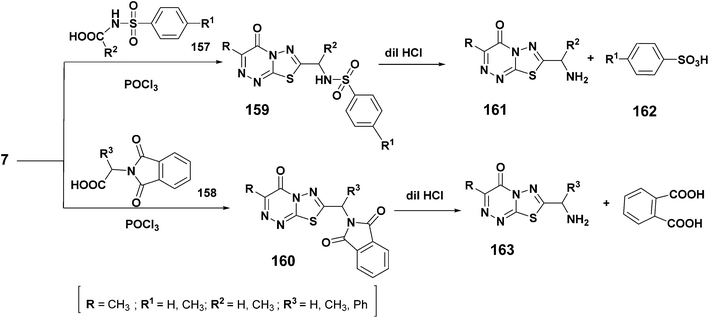 | ||
| Scheme 56 Reaction sequences of 7 with glycine derivatives to form the corresponding 1,3,4-thiadiazolo-1,2,4-triazines 159–161 and 162. | ||
Cyclocondensation reaction of aminotriazinethiones 7 [R = methyl, phenyl] with substituted benzaldehydes gave thiadiazolo[2,3-c]triazines 164.92 The reaction of 10 [R = (2-thienyl)vinyl] with ethyl chloroformate in DMF yielded 1,3,4-thiadiazolo[2,3-c]-1,2,4-triazin-4,7(6H)-dione (165).65 In addition compound 7 was reacted with brominated 1,3-dicarbonyl 166 to furnish 3,7-dimethyl-6H-pyrazolo[5,1-c]-1,2,4-triazin-4-ones 167 (Scheme 57).93
 | ||
| Scheme 57 Treatment of 6-substituted-4-amino-3-mercapto-1,2,4-triazines 7, 10 with various ketonic reagents. | ||
The mechanism for the formation of compounds 167 is postulated as shown in (Fig. 5). It proceeds by nucleophilic attack of the amino group of 3 on the carbonyl group of 166a to give 166b, followed by elimination of water from 166b to give 166c which subsequently undergoes an internal nucleophilic attack accompanied by the elimination of hydrogen sulfide to give 8-bromopyrazolo[5,1-c]-1,2,4-triazine derivatives (166d). Compound 166d undergoes a redox reaction with the eliminated hydrogen sulfide to afford the 8-bromo-6,7,8-trihydropyrazolo[5,1-c]-1,2,4-triazines (166e) and elemental sulfur. Elimination of hydrogen bromide from 166e afforded 6,7-dimethyl-6H-pyrazolo[5,1-c]-1,2,4-triazin-4-ones (167) (Fig. 6).
Once more, condensation of 167 with hydroxylamine hydrochloride in refluxing 2-propanol in the presence of triethylamine afforded the corresponding oxime derivatives 168 which were reacted with benzoyl chloride in anhydrous pyridine at 0 °C to give the corresponding benzoyloxyimino derivatives 169 through protection of the hydroxyl group. The reaction of 167 with methyl and/or phenyl hydrazine in the presence of a few drops of acetic acid in refluxing 2-propanol yielded the corresponding hydrazino derivatives 170. While, the reaction of 167, contaminated with elemental sulfur, with phenyl hydrazine in refluxing 2-propanol furnished bis(3,7-dimethyl-4-oxo-4,6-dihydropyrazolo[5,1-c]-1,2,4-triazin-8-yl)disulfide (171) (Scheme 58).93
 | ||
| Scheme 58 Synthesis of pyrazolo-1,2,4-triazine derivatives using 167 as starting materials with different nitrogen containing reagents. | ||
Treatment of 167 with hydrazine hydrate in 2-propanol at room temperature afforded the hydrazinium salts 172 which by refluxing in 2-propanol in the presence of a few drops of acetic acid furnished N,N′-bis[(3,7-dimethyl-4-oxo-4,6-dihydro-pyrazolo[5,1-c]-1,2,4-triazin-8-yl)-ethylidene(and/or benzylidene)]hydrazine (173). Compound 173 was prepared directly by the reaction of 167 with hydrazine hydrate in refluxing 2-propanol in the presence of a few drops of acetic acid (Scheme 59).93
 | ||
| Scheme 59 Transformation of 167 to the corresponding hydrazinum salt 172 which consequently converted to the bis-compound 173. | ||
Whereas, addition of ammonium thiocyanate to compound 10 [R =(2-thienyl)vinyl] in glacial acetic acid yielded the corresponding thiourea 174 and 1,2,4-triazine derivatives 175, respectively in (34%, 42%) yield.66 In addition, cyclocondensation of triazinone 7 [R = methyl] with RSCN in the presence of polyphosphoric acid afforded 1,3,4-thiadiazolo[2,3-c]-1,2,4-triazin-4-ones 176.94 Also, reaction of 1,2,4-triazinone (7) with aryl isothiocyanat under neutral conditions afforded 1,3,4-thiadiazolo[2,3-c]-1,2,4-triazin-4-ones 177 (Scheme 60).95
 | ||
| Scheme 60 Heterocyclization of compound 10 via sulfur-containing reagents to form the respective triazolotriazines 175–177. | ||
Boiling of compound 10 [R = (2-thienyl)vinyl] with carbon disulphide in dil. ethanolic KOH afforded 3-(2-(thiophen-2-yl)vinyl)-7-thioxo-6,7-dihydro-4H-1,3,4-thiadiazolo[2,3-c]-1,2,4-triazin-4-ones (178) which showed cytotoxic activity against different cancer cell lines.65 Also, reaction of 7 (R = methyl) with substituted benzonitrile in the presence of potassium t-butoxide in t-butyl alcohol afforded the corresponding 1,2,4-triazolo[1,5-d]-1,2,4-triazin-5-ones 179 (Scheme 61).96
Condensation of 7 [R = t-butyl] and 10 [R = (2-thienyl)vinyl] with activated methylene compounds (cyanoacetic ester or malonodinitrile) in pyridine afforded the respective pyrazolo[5,1-c]-1,2,4-triazines 180.65,79 While, condensation of 7 [R = methyl] with cyanoacetic ester in polyphosphoric acid furnished 1,2,4-triazolo[3,4-b]-1,3,4-thiadiazole 181 which exhibited an appreciable fungicidal activity against F. moniliforme, P. oxalicum, and A. niger (Scheme 62).98
Acetylation of compound 180 [R2 = COOC2H5] with acetic anhydride in pyridine and benzoyl chloride [R1 = CN, COOC2H5] in ethyl acetate afforded 182. Boiling of compound 180 [R2 = CN] in alcoholic medium with ketones led to isolation of pyrazolo[5,1-c]-1,2,4-triazine-8-carbonitriles 183. Substitution of the ethoxy group in compound 180 [R2 = COOC2H5] by a hydrazine group occurs on its boiling in 2-propanol with a 100% excess of hydrazine hydrate afforded pyrazolo[5,1-c]-1,2,4-triazine-8-carboxylic acid 184. In addition, boiling of the compound 180 [R2 = COOC2H5] in alcoholic alkali leads to potassium salt 185, which acidified with HCl (pH 5–6) to give the corresponding carboxylic acid 186 (Scheme 63).97
Treatment of ethyl 2-(3-methyl-4-oxo-4H-1,3,4-thiadiazolo[2,3-c]-1,2,4-triazine-7-yl)acetate (181) with 2-nitrobenzaldehyde in boiling acetic acid, followed by addition of Zn powder, resulted in the formation 1,3,4-thiadiazolo[2,3-c]-1,2,4-triazine 187 which formed via condensation of the aldehyde at the activated methylene group in 181, then reduction of the nitro group to amino and subsequent cyclization at the ester moiety with loss of ethanol. Similarly, 4-hydroxycoumarin analog 188 was obtained by the reaction of 181 with 5-chlorosalicyloyl chloride. In addition, treatment of 181 with carbon disulfide in the presence of sodium ethoxide and excess methyl iodide afforded the corresponding bis(methylsulfanyl)methylidene 189 which then reacted with hydrazine hydrate to furnish the corresponding pyrazolyl-1,3,4-thiadiazolo[2,3-c]-1,2,4-triazin-4-one derivative 190. Also, reaction of 181 with N,N-dimethyl formamide dimethyl acetal gave adduct 191 which then treated with hydrazine hydrate to give the respective pyrazolone 192 (Scheme 64).98
A series of 1,2,4-triazino[3,4-b]-1,3,4-thiadiazin-4-ones 194 have been synthesized by the reaction of 4-amino-6-phenyl-3-mercapto-1,2,4-triazine-5(4H)-ones (7) with the appropriate bis(α-bromo ketones) 193 in refluxing ethanol (Scheme 65).99
 | ||
| Scheme 65 Synthesis of bis(1,2,4-triazino-1,3,4-thiadiazines 194) from 3 or 7 and bis(α-bromo ketones). | ||
Condensation of 3-bromoacetyl coumarin derivatives 195 with 6-(substituted)-4-amino-3-mercapto-1,2,4-triazin-5-ones 3 and 7 in anhydrous ethanol and DMF afforded 7-(2-oxo-2H-1-benzopyran-3-yl)-4H,8H-1,2,4-triazino[3,4-b]-1,3,4-thiadiazin-4-ones derivatives 196 which showed antibacterial, antioxidant activities104–106 and antiviral effect.86 Also, reaction of 3-aryl-4-bromo acetyl sydnones 197 with 7 gave 3-(4H,8H-1,2,4-triazino[3,4-b]-1,3,4-thiadiazin-7-yl)-1,2,3-oxadiazolium derivatives 198 (Scheme 66).100–102
Heterocyclization reaction between 6-(substituted)-4-amino-3-mercapto-1,2,4-triazin-5-ones 7 and 10 with bifunctional oxygen and halogen compounds afforded fused hetero bicyclic systems such as 1,2,4-triazino[3,4-b]-1,3,4-thiadiazinones 199–202 which showed a significant activity in leukemia, lung, breast and CNS anticancer evaluation (Scheme 67).33,65,103
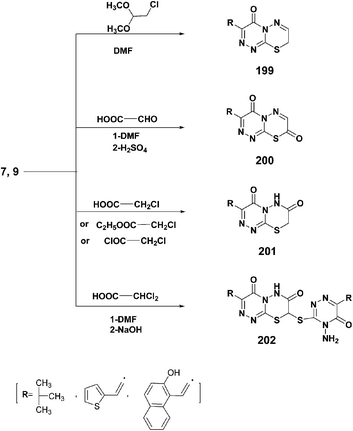 | ||
| Scheme 67 Heterocyclization reaction of between 1,2,4-triazinones 7, 10 with bifunctional oxygen and halogen compounds to form triazinothiadiazines 199–202. | ||
In addition, 6-(substituted)-4-amino-3-mercapto-1,2,4-triazin-5-ones 10 were reacted with oxalyl chloride in DMF yielded 1,2,4-triazino[3,4-b]-1,3,4-thiadiazin-4,7,8-trione derivatives 203 which showed anticancer activity.33,65 Also, reaction of compound 7 with 2-bromopropionyl bromide in refluxing anhydrous benzene and triethylamine furnished 3,8-dimethyl-1,2,4-triazino[3,4-b]-1,3,4-thiadiazine-4,7-diones (205) which used as antiviral agent.84 Moreover, 1-(benzofuran-2-yl)-3-(3-(benzofuran-2-yl)-1-phenyl-1H-pyrazol-4-yl)-2-bromoprop-2-en-1-one (206) when reacted with 7 in the presence of triethylamine and ethanol, a compound 207 was obtained which exhibited promising molluscicidal activities (Scheme 68).104
 | ||
| Scheme 68 Reactions of 7, 10 with a variety of haloketones to yield their respective heterobicyclic systems 204–207. | ||
Cycloaddition of compound 10 with dimedone in boiling DMSO with a few drops of piperidine afforded compounds 208.33,65 Whereas, 3-methyl-6-nitro-10H-benzo-1,2,4-thiadiazino[2,3-c]-1,2,4-triazin-4-one (209) was obtained by refluxing compound 7 [R = methyl] with 1-chloro-2,4-dinitrobenzene in dimethylformamide through the elimination of one molecule of hydrogen chloride and one molecule of nitrous acid.84 In addition, 10-methyl-7H,9H-1,2,4-triazino[3′,4′:2,3]-1,3,4-thiadiazino[5,6-c] cinnolin-9-one (210) was obtained via cyclocondensation of 7 [R = methyl] with 3,4-dichlorocinnoline.105 On the other hand, when 6-methyl-4-amino-3-mercapto-1,2,4-triazin-5-one (7) was condensed with bromo malononitrile in the presence of base afforded 1,2,4-triazino[2,3-c]-1,3,4-thiadiazine 211 which in turn reacted with phenacyl bromide gave the corresponding heterotricyclic system, imidazo[1,2-b]triazino-1,3,4-thiadiazine 212 (Scheme 69).106
 | ||
| Scheme 69 Cyclocondensation reactions of 7, 10 with bifunctional carbocyclic, aromatic, heterocyclic and aliphatic reagents. | ||
Condensation of 7 [R = methyl] with allyl bromide in butanol and in presence of NaOH furnished 3-allylthio-4-amino-6-methyl-1,2,4-triazin-5-one (213). The latter was treated with excess of bromine in chloroform to afford 214 and 215 (Scheme 70).103
In addition, 4-amino-6-methyl-1,2,4-triazine-3(2H)-thione-5-one (7) was condensed with propargyl bromide in the presence of sodium methoxide to afford the corresponding 3-propargylmercapto derivatives 216. Its cyclization could be accomplished either by refluxing in acetic acid with a catalytic amounts of heteropolyacides (HPA) H6P2W18O60 to afford 3,7-dimethyl-4H,6H-1,2,4-triazino[3,4-b]-1,3,4-thiadiazin-4-one (217) or by refluxing in acetonitrile in the presence of a catalytic amount of PdCl2(PhCN)2 to afford 3-methyl-7-methylene-7,8-dihydro-4H,6H-1,2,4-triazino [3,4-b]-1,3,4-thiadiazin-4-one (218). It can be assumed that HPA catalyzed pathway proceeds via direct attack of the amino group of the acetylenic bond activated by proton coordination of HPA, followed by isomerization to convert the methylene moiety to a methyl group while, using of Pd-salt for implementation of sequential carbometallation anion capture and catalyzed intermolecular cyclization and functionalization of acetylene (Scheme 71).107
 | ||
| Scheme 71 Reaction of 7 with propargyl bromide to form 216 which undergo cyclization with different catalysis. | ||
Regarding, the reaction of compound 4-amino-6-methyl-1,2,4-triazin-3(2H)-thione-5-one (7) with acetyltriphenylphosphonium chloride [(C6H5)3P+COCH3Cl−] and phenacyltriphenylphosphonium bromide [C6H5COCH2P+(C6H5)3Br−] in boiling DMF containing a catalytic amount of piperidine afforded 1,2,4-triazino[4,3-e]-1,4,5,2-thiadiazaphosphinine 219 and 1,2,4-triazino[4,3-f]-1,5,6,2-thiadiazaphosphepine 220 derivatives, respectively (Scheme 72). Formation of compounds 219 and 220 may occur through the attack of electrons of the lone pair of the SH group on the phosphorus atom of the phosphonium salt to remove hydrogen halide followed by an intramolecular nucleophilic attack of the amino group on the carbonyl group with elimination of water to give 219 and 220, respectively (Scheme 72).68
3.6. Miscellaneous reactions
Thiation of 7 [R = methyl] with phosphorus pentasulfide in boiling anhydrous pyridine afforded 4-amino-3-mercapto-6-methyl-1,2,4-triazin-5(4H)-thione (221). Treatment of compound 221 with 4-bromophenacyl bromide in boiling methanol yielded a separable mixture of 2-((4-amino-6-methyl-5-thioxo-4,5-dihydro-1,2,4-triazine-3-yl)thio)-1-(4-bromophenyl)ethan-1-one (222) and 7-(4-bromophenyl)-3-methyl-4H,8H-1,2,4-triazino[3,4-b]-1,3,4-thiadiazine-4-thione (223), respectively in (44%, 21%) yield. Compounds 221 and 222 were separated from the mixture by treatment with boiling dilute acetic acid that dissolved 222 (Scheme 73).62 | ||
| Scheme 73 Treatment of triazine with thiation reagent followed by 4-bromophenacyl bromide to produce 222 and 223. | ||
6-(Arylvinyl)-3-mercapto-1,2,4-triazine-5(4H)-ones 10 were reacted with phosphorus pentasulfide in boiling anhydrous pyridine afforded 6-arylthieno[2,3-e]-1,2,4-triazine-3-thiols (224). While, 6-(arylvinyl)-3-methylthio-1,2,4-triazin-5(4H)-ones 18 under the same condition afforded a mixture of 224 and 225. The conversion of 10 or 18 to 224 and 225 formed via condensation with phosphorus pentasulfide followed by deamination.108 Compound 224 readily methylated with methyl iodide in sodium methoxide afforded the 3-(methylthio)-6-arylthieno[2,3-e]-1,2,4-triazins 225 (Scheme 74).
 | ||
| Scheme 74 Condensation of 10 and 18 with phosphorus pentasulfide followed by deamination to give 224 and 225. | ||
Reduction of 4-amino-6-(t-butyl)-3-mercapto-1,2,4-triazin-5(4H)-one (7) by sodium-amalgam in water afforded 4-amino-6-(tert-butyl)-3-mercapto-1,6-dihydro-1,2,4-triazin-5(4H)-one (226). This successful reduction conducted below 5 °C because in higher temperature (above 5 °C) causes ring opening to give thiocarbohydrazidoacetic acids. S-methylation of 226 with sodium hydroxide gave rise to 4-amino-6-(t-butyl)-3-(methylthio)-1,6-dihydro-1,2,4-triazin-5(4H)-one (227) (Scheme 75).109
Acetylation of 227 with acetic anhydride provided predominantly the N-1 acetylated compound 228 suggesting that the hydrogen atom at the N-1 position is more acidic than that of the exo amino group. Moreover, N-1 methylated compound 229 was prepared via reaction of 227 with methyl iodide in presence sodium hydride at 25 °C, ethylmagnesium iodide at 25 °C and/or sodium hydroxide at 70 °C. Alkylation of 227 with benzyl bromide in sodium hydride afforded 4-amino-1-benzyl-6-(t-butyl)-3-methylthio-1,6-dihydro-1,2,4-triazin-5(4H)-one (230) which methylated in n-butyl lithium to afford 1-benzyl-6-(t-butyl)-4-methylamino-3-methylthio-1,6-dihydro-1,2,4-triazin-5(4H)-one (231) (Scheme 76).109
In contrast, the anion produced by n-butyl lithium at −20 °C 227 was directed to the methylation of the exo amino group gave 232 which reacted with benzyl bromide in sodium hydride afforded 233. Alkylation of 227 with allyl bromide in n-butyl lithium at −20 °C afforded 4-allylamino-6-t-butyl-3-methylthio-1,6-dihydro-1,2,4-triazin-5(4H)-one (234) (Scheme 77).109
4. Conclusion
This review serving the synthesis and reactions of 1,2,4-triazine systems from 1983-up to the beginning 2015. It implies many sections on the synthesis of 1,2,4-triazine heterocyclic from different starting materials. Moreover, the reactions of these triazine systems with different reagents were presented. Eventually, this review focuses on 1,2,4-triazine moieties science they are known as prominent structural core system present in numerous pharmacologically active compounds.References
- (a) R. Kumar, T. S. Sirohi, H. Singh, R. Yadav, R. K. Roy, A. Chaudhary and S. N. Pandeya, Mini-Rev. Med. Chem., 2014, 14, 168–207 CrossRef CAS PubMed; (b) H. Li, H. Zhou, S. Krieger, J. J. Parry, J. J. Whittenberg, A. V. Desai, B. E. Rogers, P. J. A. Kenis and D. E. Reichert, Bioconjugate Chem., 2014, 25, 761–772 CrossRef CAS PubMed.
- H. M. Ashour, M. H. El-Wakil, M. A. Khalil, K. A. Ismail and I. M. Labouta, Med. Chem. Res., 2013, 22, 1909–1924 CrossRef CAS.
- W. A. Creasey, M. E. Fink, R. E. Handschumacher and P. Calabresi, Cancer Res., 1963, 23, 444–453 CAS.
- Z. El-Gendy, J. M. Morsy, H. A. Allimony, W. R. Abdel-Monem and R. M. Abdel-Rahman, Phosphorus, Sulfur Silicon Relat. Elem., 2003, 178, 2055–2071 CrossRef CAS.
- Z. K. El-Samii, J. Chem. Technol. Biotechnol., 1992, 53, 143–146 CrossRef.
- M. P. Hay, F. B. Prujin, S. A. Gamage, H. D. Liyanage and W. R. Wilson, J. Med. Chem., 2004, 47, 475–488 CrossRef CAS PubMed.
- W. P. Heilman, R. D. Heilman, J. A. Scozzie, R. J. Wayner, J. M. Gullo and Z. S. Riyan, J. Med. Chem., 1979, 22, 671–677 CrossRef CAS PubMed.
- A. Agarwal, K. Srivastava, S. K. Puri and P. M. S. Chauhan, Bioorg. Med. Chem. Lett., 2005, 15, 531–533 CrossRef CAS PubMed.
- T. Gucky, I. Frysova, J. Slouka, M. Hajduch and P. Dzubak, Eur. J. Med. Chem., 2009, 44, 891–900 CrossRef CAS PubMed.
- F. Krauth, H. Dahse, H. Ruttinger and P. Frohberg, Bioorg. Med. Chem., 2010, 18, 1816–1821 CrossRef CAS PubMed.
- (a) L. H. Pal chykovska, M. O. Platonov, I. V. Alexeeva and A. D. Shved, Biopolim. Kletka, 2004, 20, 131–142 CAS; (b) D. N. Kamber, Y. Liang, R. J. Blizzard, F. Liu, R. A. Mehl, K. N. Houk and J. A. Prescher, J. Am. Chem. Soc., 2015, 137(26), 8388–8839 CrossRef CAS PubMed.
- J. C. Hegde, K. S. Girisha, A. Adhikari and B. Kalluraya, Eur. J. Med. Chem., 2008, 43(12), 2831–2834 CrossRef CAS PubMed.
- M. Ashok and B. S. Holla, Phosphorus, Sulfur Silicon Relat. Elem., 2007, 182(5), 981–991 CrossRef CAS.
- M. M. Eid, R. A. Hassan and A. M. Kadry, Pharmazie, 1988, 43(3), 166–167 CAS.
- K. Dickore, H. J. Santel, R. R. Schmidt and H. Strang, DE 3710255, A1, 1988.
- A. S. Ramasubramanian, B. Ramachandra Bhat and R. Dileep, Synth. React. Inorg., Met.-Org., Nano-Met. Chem., 2012, 42(4), 548–553 CrossRef CAS.
- B. C. Revanasiddappa and E. V. S. Subrahmanyam, Int. J. Chem. Sci., 2009, 7(1), 468–474 CAS.
- B. C. Revanasiddappa and E. V. S. Subrahmanyam, Indian J. Heterocycl. Chem., 2010, 19(3), 291–292 CAS.
- N. A. Salahuddin, A. A. El-Barbary and N. I. Abdo, Polym. Compos., 2009, 30(8), 1190–1198 CrossRef CAS.
- A. Dornow, H. Heinrich Marquardt and H. Paucksch, Chem. Ber., 1964, 97(8), 2165–2168 CrossRef CAS.
- M. Ghassemzadeh, S. Bahemmat, M. Tabatabaee, S. Nassiri and B. Neumüller, Polyhedron, 2011, 30, 1760–1766 CrossRef CAS.
- E. Kranz, K. J. Reubke, K. Luerssen, H. J. Santel, R. R. Schmidt and B. Krauskopf, BirgitAssignee: Bayer A.-G., Germany, Eur. Pat. Nov 28, EP 399310, A1, 1990.
- K. Sivasankaran, S. K. Rao, M. S. Mithyantha, S. K. Bhat and S. Suresh, Patent Indian, IN 181368 A1, May 30 1998.
- T. Schmidt, A. Wittig, H. P. Sehnem, H. Kraetzer and R. J. Singer, DE 3003541, A1, 1981.
- E. Kranz, H. J. Santel and R. R. Schmidt, Eur. Pat374622, A2, 1990.
- E. Kranz, M. Jautelat, L. Eue and R. R. Schmidt, DE 3240308 A1, 1984.
- E. Kranz, K. Findeisen, H. Fiege, L. Eue and R. R. Schmidt, DE 3323934 A1, 1985.
- E. Kranz, K. Findeisen, L. Eue and R. R. Schmidt, DE 3201110 A1, 1983.
- E. Kranz, K. Findeisen, L. Eue and R. R. Schmidt, DE 3135413 A1, 1983.
- E. Kranz, H. J. Santel, K. Luerssen and R. R. Schmidt, DE 3912508 A1, 1990.
- K. Hirai and H. Sugimoto, Jpn. Kokai JP 61134389 A2, 1986.
- B. S. Holla, R. Gonsalves and B. K. Sarojini, Indian J. Chem., 1997, 36, 943–946 Search PubMed.
- Z. El-Gendy, J. M. Morsy, H. A. Allimony, W. R. Abdel-Monem Ali and R. M. Abdel-Rahman, Pharmazie, 2001, 56(5), 376–383 CAS.
- P. M. Kovbasa, A. M. Demchenko, V. V. Sukhoveev and O. S. Smol'skii, Farm. Zh., 2009, 6, 63–68 Search PubMed.
- W. Schwarze, A. Kleemann and W. Leuchtenberger, DE 3106707 A1, 1982.
- E. Kranz, K. Findeisen, L. Eue and R. R. Schmidt, DE 3323933 A1, 1985.
- E. Kranz, H. J. Santel, K. Luerssen, R. R. Schmidt and B. Krauskopf, DE 3917043 A1, 1990.
- V. K. Khamaev, V. A. Danilov, R. N. Khannanov and A. K. Mazitova, Russ. J. Org. Chem., 1994, 30(5), 825–829 (Zh. Org. Khim., 1994, 30, 777–781) Search PubMed.
- B. S. Holla, M. K. Shivananda, B. Veerendra and K. S. Bhat, Indian J. Chem., 2003, 42, 2649–2651 Search PubMed.
- I. A. Al-Juwaiser, M. R. Ibrahim, N. A. Al-Awadi and Y. A. Ibrahim, Tetrahedron, 2008, 64, 8206–8212 CrossRef CAS.
- M. A. Metwally, M. E. Khalifa and M. Koketsu, Am. J. Chem., 2012, 2(2), 38–51 CrossRef.
- M. A. Badawy, S. A. L. Abdel-Hady, M. M. Eid and A. Ibrahim, Chem. Ber., 1984, 117, 1083–1088 CrossRef CAS.
- A. K. Mansour, M. M. Eid and N. S. A. M. Khalil, Nucleosides, Nucleotides Nucleic Acids, 2003, 22(1), 21–44 CAS.
- S. A. Abdel-Hady, Sulfur Lett., 1990, 11(3), 117–122 CAS.
- S. A. Abdel-Hady and B. Mohamed, Sulfur Lett., 1990, 11(4–5), 185–191 CAS.
- G. Pissiotas, W. Schwarze, H. Klenk and W. Leuchtenberger, DE., 2732797 A1, 1979.
- H. Klenk, W. Schwarze and W. Leuchtenberger, US. Pat., 4,175,188, 1979.
- L. M. Mironovich, G. S. Salistaya and V. K. Promonenkov, Russ. J. General Chem., 2001, 71(6), 991–992 (Zh. Obshch. Khim., 2001, 71, 1052–1053) CrossRef CAS.
- F. Sauter, U. Jordis and S. M. Siddiqi, J. Chem. Res., 1986, 9, 320–321 Search PubMed.
- A. M. Demchenko, V. V. Kislyi and M. O. Lozinskii, Ukr. Khim. Zh., 2002, 68(11–12), 56–59 CAS.
- N. S. A. M. Khalil, M. Abdel Kader and M. M. Eid, Nucleosides, Nucleotides Nucleic Acids, 2004, 23(12), 1889–1910 CAS.
- K. Dickore, K. Sasse, L. Eue and R. Schmidt, Eur. Pat. 15452A1, 1980.
- A. A. El-Shehawy, Heteroat. Chem., 2003, 14(3), 280–287 CrossRef CAS.
- H. A. Saad and A. H. Moustafa, Molecules, 2011, 16, 5682–5700 CrossRef CAS PubMed.
- N. Y. Slivka and Y. I. Gevaza, Ukr. Khim. Zh., 2002, 68(11–12), 89–93 CAS.
- F. Hakimi, M. Tabatabaee and M. Heravi, World Appl. Sci. J., 2012, 18(9), 1253–1256 CAS.
- I. M. Bazavova, V. N. Britsun, A. N. Esipenko and M. O. Lozinskii, Chem. Heterocycl. Compd., 2003, 39(6), 809–812 CrossRef CAS.
- V. V. Kisliy, V. A. Yanchenko and A. M. Demchenko, Chem. Heterocycl. Compd., 2003, 39(6), 823–824 CrossRef CAS.
- V. M. Britsun, V. V. Shvartau, A. M. Esipenko, V. S. Petrenko and M. O. Lozins'kii, Zh. Org. Farm. Khim., 2004, 2(1), 35–38 CAS.
- M. Ashok and B. S. Holla, Phosphorus, Sulfur Silicon Relat. Elem., 2007, 182, 1599–1608 CrossRef CAS.
- A. Al-Etaibi, E. John, M. R. Ibrahim, N. A. Al-Awadi and Y. A. Ibrahim, Tetrahedron, 2011, 67(34), 6259–6274 CrossRef CAS.
- N. R. El-Brollosy, Phosphorus, Sulfur Silicon Relat. Elem., 2000, 163, 77–89 CrossRef CAS.
- Y. A. Ibrahim, N. A. Al-Awadi and E. John, Tetrahedron, 2008, 64, 10365–10374 CrossRef CAS.
- R. H. Shoar, M. M. Heravi, L. Pedram, S. H. Raeiat and Z. Jaddi, Phosphorus, Sulfur Silicon Relat. Elem., 2005, 180(11), 2563–2567 CrossRef CAS.
- A. Dornowf and H. Pietsch, Chem. Ber., 1967, 100, 2585–2592 CrossRef.
- H. A. Saad, M. M. Youssef and M. A. Mosselhi, Molecules, 2011, 16, 4937–4957 CrossRef CAS PubMed.
- A. M. Demchenko, V. V. Kisly, Z. B. Kvacheva and M. O. Lozinsky, Zh. Org. Farm. Khim., 2003, 1(1–2), 55–58 CAS.
- T. El-Sayed Ali, Eur. J. Med. Chem., 2009, 44(11), 4539–4546 CrossRef PubMed.
- A. A. El-Barbary, Y. A. Hafiz and M. S. Abdel-Wahed, Nucleosides, Nucleotides Nucleic Acids, 2010, 29(1), 55–71 CAS.
- A. M. EL Massry, A. M. Asal, S. N. Khattab, N. S. Haiba, H. A. Awney, M. Helmy, V. Langer and A. Amer, Bioorg. Med. Chem., 2012, 20, 2624–2637 CrossRef CAS PubMed.
- J. Daunis and M. Follet, Bull. Soc. Chim. Fr., 1976, 1178–1182 CAS.
- H. Vahedi, G. Rajabzadeh and F. Farvandi, Chin. Chem. Lett., 2010, 21(12), 1419–1422 CrossRef CAS.
- A. A. El-Barbary, Y. A. Hafiz and M. S. Abdel-Wahed, J. Heterocycl. Chem., 2011, 48(3), 639–644 CrossRef CAS.
- A. S. Sami and S. M. Gomha, Tetrahedron, 2002, 58(42), 8559–8564 CrossRef.
- A. A. El-Barbary, M. A. Sakran and A. M. El-Madani, J. Heterocycl. Chem., 2005, 42(5), 935–994 CrossRef CAS.
- A. K. Mansour, M. M. Eid and N. S. A. M. Khalil, Nucleosides, Nucleotides Nucleic Acids, 2003, 22(9), 1805–1823 CAS.
- A. Al-Etaibi, S. Makhseed, N. A. Al-Awadi and Y. A. Ibrahim, Tetrahedron Lett., 2005, 46(1), 31–35 CrossRef CAS.
- K. Singh, Y. Kumar, P. Puri, C. Sharma and K. R. Aneja, Med. Chem. Res., 2012, 21, 1708–1716 CrossRef CAS.
- M. Hakimi, R. Takjoo and A. Massoudi, Org. Chem.: Indian J., 2011, 7(1), 4–6 CAS.
- M. Tabatabaee, M. Ghassemzadeh, B. Zarabi, M. M. Heravi, M. A. Abbasinejad and B. eumüller, Phosphorus, Sulfur Silicon Relat. Elem., 2007, 182(3), 677–686 CrossRef CAS.
- B. S. Holla and M. K. Shivananda, Indian J. Heterocycl. Chem., 2003, 13(1), 85–86 CAS.
- M. A. Abu-Zaied, E. M. El-Telbani, G. H. Elgemeie and G. A. M. Nawwar, Eur. J. Med. Chem., 2011, 46(1), 229–235 CrossRef CAS PubMed.
- A. A. El-Shehawy, React. Funct. Polym., 2003, 55(3), 239–247 CrossRef CAS.
- M. A. El-Badawi, A. A. El-Barbary, Y. M. Loksha and M. El-Daly, Phosphorus, Sulfur Silicon Relat. Elem., 2002, 177, 587–596 CrossRef CAS.
- B. S. Holla, M. K. Shivananda and B. Veerendra, Indian J. Chem., 2002, 41(12), 2690–2693 Search PubMed.
- D. J. Prasad, M. S. Karthikeyan, P. B. Karegoudar, B. Poojary, B. S. Holla and N. S. Kumari, Phosphorus, Sulfur Silicon Relat. Elem., 2007, 182, 1083–1091 CrossRef CAS.
- B. S. Holla, B. S. Rao, R. Gonsalves, B. K. Sarojini and K. Shridhara, Farmaco, 2002, 57, 693–696 CrossRef PubMed.
- H. Golgolab, I. Lalezari and L. H. Gohari, J. Heterocycl. Chem., 1973, 10(3), 387–390 CrossRef CAS.
- M. M. Heravi, R. A. Ibrahimina, M. Bakavoli and M. H. Arbab, Indian J. Heterocycl. Chem., 1996, 5(4), 287–290 CAS.
- B. S. Holla, K. S. Bhat and N. S. Shetty, Phosphorus, Sulfur Silicon Relat. Elem., 2003, 178(10), 2193–2199 CrossRef CAS.
- B. S. Holla, R. Gonsalves, B. S. Rao, S. Shenoy and H. N. Gopalakrishna, Farmaco, 2001, 56, 899–903 CrossRef CAS PubMed.
- H. K. Gakhar, U. Prabha and J. K. Gill, J. Indian Chem. Soc., 1984, 61(6), 552–553 CAS.
- A. A. El-Barbary, M. A. El-Badawi and Y. M. Loksha, J. Heterocycl. Chem., 2001, 38, 711–716 CrossRef CAS.
- S. S. Shakurov and M. A. Khimiya, Khim. Geterotsikl. Soedin., 1993, 1, 139–140 Search PubMed.
- P. Molina, M. Alajarin and R. Benzal, Synthesis, 1983, 9, 759–760 CrossRef.
- M. M. Heravi, N. Montazeria, M. Rahimizadeha, M. Bakavolia and M. Ghassemzadehd, J. Heterocycl. Chem., 2005, 42, 1021–1025 CrossRef CAS.
- L. M. Mironovich and M. V. Kostina, Chem. Heterocycl. Compd., 2012, 47(10), 1286–1289 CrossRef CAS (Russian Original, 47(10), October, 2011).
- E. M. El-Telbani, R. H. Swellem and G. A. M. Nawwar, Russ. J. Org. Chem., 2007, 43(12), 1815–1820 (Zh. Org. Khim., 2007, 43, 1813–1818) CrossRef CAS.
- M. R. Shaaban and A. H. M. Elwahy, J. Heterocycl. Chem., 2012, 49, 640–645 CrossRef CAS.
- B. Kalluraya, P. Vishwanatha, G. Rai and M. A. Rahiman, Indian J. Heterocycl. Chem., 2002, 11(4), 287–290 CAS.
- V. R. Rao, U. Veerabadraiah and T. V. P. Rao, Natl. Acad. Sci. Lett., 1992, 15(8), 263–265 CAS.
- W. S. Hamama, M. A. Berghot, E. A. Baz and M. A. Gouda, Arch. Pharm. Chem. Life Sci., 2011, 344, 710–718 CrossRef CAS PubMed.
- M. M. Heravi, M. A. Nooshabadi, P. Khosrofar, H. A. Oskooie, Y. S. Beheshtiha and S. Saffarzadeh, Indian J. Heterocycl. Chem., 1998, 8(2), 167–170 CAS.
- M. F. El Shehry, R. H. Swellem, S. M. Abu-Bakr and E. M. El-Telbani, Eur. J. Med. Chem., 2010, 45, 4783–4787 CrossRef CAS PubMed.
- H. K. Gakhar, R. Gupta and S. B. Gupta, J. Indian Chem. Soc., 1990, 67(4), 351–353 CAS.
- A. S. Shawali and R. A. Sayed, J. Chem. Res., 2004, 6, 399–401 CrossRef.
- R. Motamedi, M. M. Heravi, F. F. Bamoharram and A. Haeri, J. Heterocycl. Chem., 2008, 45, 1211–1214 CrossRef CAS.
- M. M. Eid, M. A. Badawy, M. A. H. Ghazala and Y. A. Ibrahim, J. Heterocycl. Chem., 1983, 20, 1709–1711 CrossRef CAS.
- M. Mizutani and Y. Sanemitsu, J. Heterocycl. Chem., 1985, 22, 11–16 CrossRef CAS.
| This journal is © The Royal Society of Chemistry 2016 |

